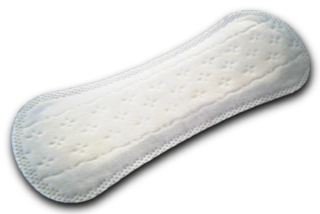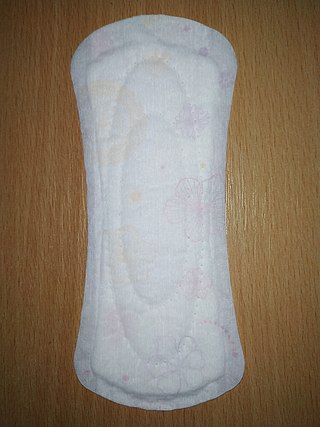
Toxic shock syndrome (TSS) is a condition caused by bacterial toxins. Symptoms may include fever, rash, skin peeling, and low blood pressure. There may also be symptoms related to the specific underlying infection such as mastitis, osteomyelitis, necrotising fasciitis, or pneumonia.

A menstrual cup is a menstrual hygiene device which is inserted into the vagina during menstruation. Its purpose is to collect menstrual fluid. Menstrual cups are usually made of flexible medical grade silicone, latex, or a thermoplastic isomer. They are impermeable and collect menstrual fluid, unlike tampons and menstrual pads, which absorb the fluid instead.

A menstrual pad, or simply a pad, is an absorbent item worn in the underwear when menstruating, bleeding after giving birth, recovering from gynecologic surgery, experiencing a miscarriage or abortion, or in any other situation where it is necessary to absorb a flow of blood from the vagina. A menstrual pad is a type of menstrual hygiene product that is worn externally, unlike tampons and menstrual cups, which are worn inside the vagina. Pads are generally changed by being stripped off the pants and panties, taking out the old pad, sticking the new one on the inside of the panties and pulling them back on. Pads are recommended to be changed every 3–4 hours to avoid certain bacteria that can fester in blood; this time also may differ depending on the kind worn, flow, and the time it is worn.

A pantyliner is an absorbent piece of material used for feminine hygiene. It is worn in the gusset of a woman's panties. Some uses include: absorbency for daily vaginal discharge, light menstrual flow, tampon and menstrual cup backup, spotting, post-intercourse discharge, and urinary incontinence. Panty liners can also help with girls who are having discharges and about to start their cycle. Pantyliners are related to sanitary napkins in their basic construction—but are usually much thinner and often narrower than pads. As a result, they absorb much less liquid than pads—making them suitable for light discharge and everyday cleanliness. They are generally unsuitable for menstruation with medium to heavy flow, which requires them to be changed more often.

Kotex is an American brand of menstrual hygiene products, which includes the Kotex maxi, thin and ultra-thin pads, the Security tampons, and the Lightdays pantiliners. Most recently, the company has added U by Kotex to its menstrual hygiene product line. Kotex is owned and managed by Kimberly-Clark, a consumer products corporation active in more than 80 countries.

Feminine hygiene products are personal care products used during menstruation, vaginal discharge, and other bodily functions related to the vulva and vagina. Products that are used during menstruation may also be called menstrual hygiene products, including menstrual pads, tampons, pantyliners, menstrual cups, menstrual sponges and period panties. Feminine hygiene products also include products meant to cleanse the vulva or vagina, such as douches, feminine wipes, and soap.

Playtex is an American brand name for undergarments, baby products, gloves, feminine hygiene products, and sunscreen. The brand began in 1947 when International Latex Corporation (ILC) created a division named Playtex to produce and sell latex products. Playtex was the first to advertise undergarments on national television in 1955, written by Howard Shavelson at Ogilvy and Mather, and the first to show a woman wearing only a bra from the waist up in a commercial in 1977. They developed space suits for the Apollo program.
Rely was a brand of superabsorbent tampons made by Procter & Gamble starting in 1975. The brand's advertising slogan was "It even absorbs the worry!", and claimed it could hold up longer than the leading tampon, because it was made differently. "Remember, They named it Rely" was the last line of most commercials.

Cloth menstrual pads are cloth pads worn in the underwear to collect menstrual fluid. They are a type of reusable menstrual hygiene product, and are an alternative to sanitary napkins or to menstrual cups. Because they can be reused, they are generally less expensive than disposable pads over time, and reduce the amount of waste produced.

Lil-lets is a brand providing feminine hygiene products that operates principally in the UK, Ireland and South Africa. Since 2000, the company has restructured through two management buyouts (MBO) to become a business crossing all sectors of the feminine hygiene market, including tampons, sanitary napkins, pantyliners and intimate care. They also do programmes for schools that teach young girls the changes that occur when they begin to menstruate.
Judith Esser-Mittag, commonly known as Judith Esser, was a German gynecologist. Her extensive studies of the female anatomy helped her to create an environmentally friendly tampon with no applicator.
Women's Voices for the Earth (WVE) is a feminist, women-led, North American environmental organization that specializes in research and advocacy regarding toxic chemicals used in products that disproportionately impact women's health, including cosmetics, menstrual care products, professional salon and cleaning products. WVE is a non-profit organization whose mission is to amplify women's voices to eliminate toxics that harm communities and health. With its inclusive vision of environmental work WVE has become a hub for visionary feminist environmentalism that recognizes the systemic connections between health, class, race, and the environment. Addressing the inter-connectivity of these various channels of exposure to toxic chemicals has been key to WVE's approach which is multi-scalar: targeting consumer behaviors, corporate practices, and government policies.

o.b. is a brand of tampon, originally developed in Germany in 1950 and manufactured by Carl Hahn GmbH. It is now owned by Edgewell Personal Care. The product was named by the gynecologist Judith Esser-Mittag who also developed it. The initials o.b. are an abbreviation of the German phrase ohne Binde.

Tampon tax is a popular term used to call attention to tampons, and other feminine hygiene products, being subject to value-added tax (VAT) or sales tax, unlike the tax exemption status granted to other products considered basic necessities. Proponents of tax exemption argue that tampons, sanitary napkins, menstrual cups and comparable products constitute basic, unavoidable necessities for women, and any additional taxes constitute a pink tax.
Sharra L. Vostral is a Professor of History and Science and Technology at the College of Liberal Arts at Purdue University. She has written two books about menstruation and history: Under Wraps: A History of Menstrual Hygiene Technology and Toxic Shock: A Social History.

Menstrual hygiene management (MHM) or menstrual health and hygiene (MHH) refers to access to menstrual hygiene products to absorb or collect the flow of blood during menstruation, privacy to change the materials, and access to facilities to dispose of used menstrual management materials. It can also include the "broader systemic factors that link menstruation with health, well-being, gender equality, education, equity, empowerment, and rights". Menstrual hygiene management can be particularly challenging for girls and women in developing countries, where clean water and toilet facilities are often inadequate. Menstrual waste is largely ignored in schools in developing countries, despite it being a significant problem. Menstruation can be a barrier to education for many girls, as a lack of effective sanitary products restricts girls' involvement in educational and social activities.
The Robin Danielson Feminine Hygiene Product Safety Act is a proposed act of the United States Congress, directing the National Institutes of Health (NIH) to research the possible health risks of menstrual hygiene products made with dioxins, synthetic fibers, chemicals such as chlorine or fragrance irritants. It also called for the Food and Drug Administration (FDA) to monitor dioxin levels in similar hygiene products.

Period underwear are absorbent garments designed to be worn during menstruation. Period underwear is designed like conventional underwear but it is made up of highly absorbent fabrics to soak up menstrual blood. Most commercially manufactured period underwear makes use of microfiber polyester fabric. It is recommended that period underwear should be changed every 8-12 hours to avoid leakage and infection.

Period poverty is a term used to describe a lack of access to proper menstrual products and the education needed to use them effectively. In total, there are around 500 million menstruators that cannot manage their periods safely due to lack of menstrual products and for fear of shame. The American Medical Women's Association defines period poverty as "the inadequate access to menstrual hygiene tools and educations, including but not limited to sanitary products, washing facilities, and waste management".
Natracare is a British feminine hygiene brand that produces organic and plastic-free menstrual products, including tampons, sanitary pads and panty liners.





















